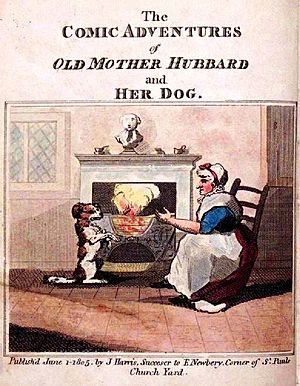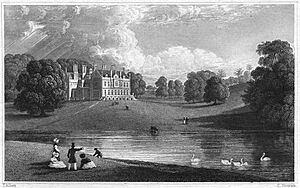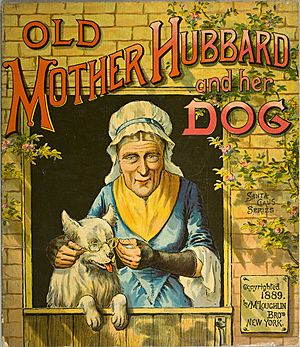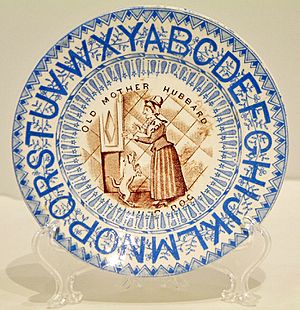Old Mother Hubbard facts for kids
Quick facts for kids "Old Mother Hubbard" |
|
|---|---|

The Comic Adventures of Old Mother Hubbard and Her Dog; London : J. Harris; 1805, first edition
|
|
| Nursery rhyme | |
| Published | 1805 |
| Songwriter(s) | Sarah Catherine Martin |
"Old Mother Hubbard" is a famous English nursery rhyme. It was first published in a longer version in 1805. The exact start of the rhyme is not fully known. This rhyme has a special number in the Roud Folk Song Index, which helps keep track of folk songs. After becoming very popular with children, it was used in many fun and useful ways.
Contents
The Story of the Rhyme
The first published book of The Comic Adventures of Old Mother Hubbard and her Dog came out in 1805. It is believed to be written by Sarah Catherine Martin (1768–1826). She was staying at Kitley House in Yealmpton, Devon, near a small cottage that is now known as Mother Hubbard's. The book had 15 pictures and was dedicated to her host, John Pollexfen Bastard.
The poem starts with these well-known lines:
Old Mother Hubbard
Went to the Cupboard,
To give the poor Dog a bone;
When she came there,
The Cupboard was bare,
And so the poor Dog had none.
She went to the Bakers
To buy him some Bread;
When she came back
The Dog was dead!
She went to the Undertakers
To buy him a coffin;
When she came back
The Dog was laughing.
After these first three parts, the poem continues with more adventures of Mother Hubbard and her dog. The number of these extra parts changed in different books. Some people think that only the parts after the first three were written by Ms. Martin. A review from 1806 mentioned that the first part of the poem was much older. The reviewer, Sarah Trimmer, was born in 1741, which means she remembered the rhyme from 50 years or more before 1805.
A music version of the first lines was made by Samuel Arnold in 1797. In his song, Mother Hubbard was trying to help "the poor Children" instead of a dog. Another song by Arnold, "There was an Old Woman Who Lived in a Shoe", had similar rhyming lines about a coffin and laughing. This made James Orchard Halliwell believe that the story of "Old Mother Hubbard" was very old.
Another silly song, Old Dame Trot and her Wonderful Cat, was published in 1803. It had a similar idea: the Dame looks for fish but finds none. Then, the cat seems to die but comes back to life, just like Mother Hubbard's dog. In both stories, the animals do funny things like smoking pipes or playing music. Mother Hubbard's dog is extra clever, sometimes knowing what his mistress will bring before she even gets back!
How the Book Became Popular
The book became popular very quickly, thanks to the smart marketing of the publisher, John Harris. To keep people excited, Harris asked Sarah Catherine Martin to write a follow-up story where the dog finds a bride. He also published another sequel written by someone else.
The rhyme was so well-known that a writer named Peter Pindar even joked about it in one of his poems. He said that people were too interested in "Mother Hubbard’s Tales" instead of more serious works.
Over the years, many other publishers made their own versions of the book. The first American edition in 1807 was called "A curious account of the comic adventures of Old Mother Hubbard and her dog." Early books used pictures drawn by the author. But in 1819, a new edition came out with different pictures by Allen Robert Branston. This book had a new subtitle: "In which is shewn the wonderful powers that good old lady possessed in the education of her favourite animal."
Books printed outside London often had simpler pictures. For example, a 1840 edition from Devonport was called The droll adventures of Mother Hubbard and her dog. Another 1840 edition from Banbury added more lines to the poem. Around the same time, New Adventures of Mother Hubbard came out, showing the pair on new adventures like visiting the zoo or traveling by train and balloon!
Some versions of the book were even made into moveable books. These had paper tabs that children could pull to make Mother Hubbard's hands move or her dog nod its head, bow, or spin wool.
Learning with Mother Hubbard
John Harris's books helped change children's books from just teaching morals to also being fun. His Mother Hubbard series was a big part of this change. Other publishers found ways to mix fun with learning. One American publisher included a full set of letters and numbers in the book to help children learn to read. An English printer put letters and numbers along the edges of his picture book. Later, plates with the alphabet and scenes from the rhyme were made for nurseries. Pictures of Mother Hubbard and her dog were also used on money boxes to encourage saving, and on cards for games like snap to help memory.
Mother Hubbard Around the World
From the 1830s, the rhyme was translated and changed in many European countries. In France, a book called Aventures plaisantes de Madame Gaudichon et de son chien (Pleasant Adventures of Madame Gaudichon and her Dog) came out in 1832. In this version, the dog was named Zozo.
Around 1830, a German translation appeared, called Komische Abentheuer der Frau Hubbard und ihrein Hunde (The Comic Adventures of Dame Hubbard and her Dog). It used the same pictures as the Robert Branston edition. Later, another German translation came out called Geschichte der Madam Rips und ihres Hundes Bello (The Tale of Madam Rep and her Dog Woof).
Then came two Dutch translations. In the 1850s, Kluchtige tafereelen van Grootje Goedsloof met haar aardig hondje Blaf (Comical Scenes of Granny Goodleaf with her Pretty Doggy Woof) was published. This version had rhyming captions for the pictures and told the story in a more relaxed way. In 1860, Moeder Hubbard en haar hond (Mother Hubbard and her Dog) was released. This one stuck closer to the original story but was also longer. The first lines of this Dutch version, which are not in the English original, show its chatty style:
Dame Hubbard had a hound,
No fairer could be found,
He sprang now here, now there,
And kiddies, ain’t this rare,
Was cleverest to hand
In all of doggie-land.
In 1976, a Chinese translation by H.Y. Xiao was published, with detailed pictures by Walter Crane from 1873. More recently, Gabriella Rouf used Robert Branston's pictures for her Italian translation, Le divertenti avventure di Nonna Renza e il suo cane (2014). In this book, Granny Rep (Nonna Renza) is named after a fabric called "rep," which was used to make dresses known as Mother Hubbard dresses.
There have also been two Russian translations. Babushka Zabavushka i sobachka Bum (The Jolly Grandma and her Little Dog Boom, 1906) by Raisa Kudasheva added a scene where the dog takes a sled ride. While the dog is usually shown as clever, the "Pudel" (Poodle) in Samuil Marshak’s 1927 version is mostly mischievous. This version was even made into a short animated film in 1985 by Nina Shorina.
Other Uses of Mother Hubbard
Pantomime Shows
In 1818, a funny play mentioned characters like Mother Goose, Tom Thumb, and Old Mother Hubbard. It wasn't clear what kind of show this was. But about ten years later, a Christmas pantomime at the Theatre Royal, Drury Lane was based on the "familiar nursery-tale of Old Mother Hubbard and her dog."
After this, many well-known characters were put into the same shows. For example, Mother Hubbard and Her Dog or Harlequin & Tales of the Nursery was performed in 1833. In 1861, another show, Harlequin and the House that Jack Built or Old Mother Hubbard and her Wonderful Dog, opened with Mother Hubbard and her dog joined by other famous characters like Dame Trot with her cat.
This idea of mixing characters still happens today. In David Wood’s 1975 play, Mother Hubbard meets the old woman who lived in a shoe again. More recently, Paul Reakes wrote Old Mother Hubbard - A Wild West Pantomime Adventure in 1993, giving the story a fun new twist.
Political Messages
Long before the nursery rhyme, there was an older story called Mother Hubberd's Tale by Edmund Spenser in 1591. This was a different kind of story, a funny fable about an ape and a fox that made fun of politics. In 1604, Thomas Middleton wrote Father Hubburd’s Tales, which also had political fables.
Some people thought Sarah Catherine Martin's rhyme might have a secret political meaning at first, but there's no real proof of this. However, it was soon used in political discussions. For example, a politician named George Canning once compared the strength of the British government to how quickly Mother Hubbard's dog came back to life. Later, her "bare cupboard" was used in many political cartoons, often to talk about money problems. These cartoons appeared in American magazines like The Wasp (1881) and Judge (1897), and a British poster in 1905 was titled "The Cupboard Still Bare."
Images for kids







